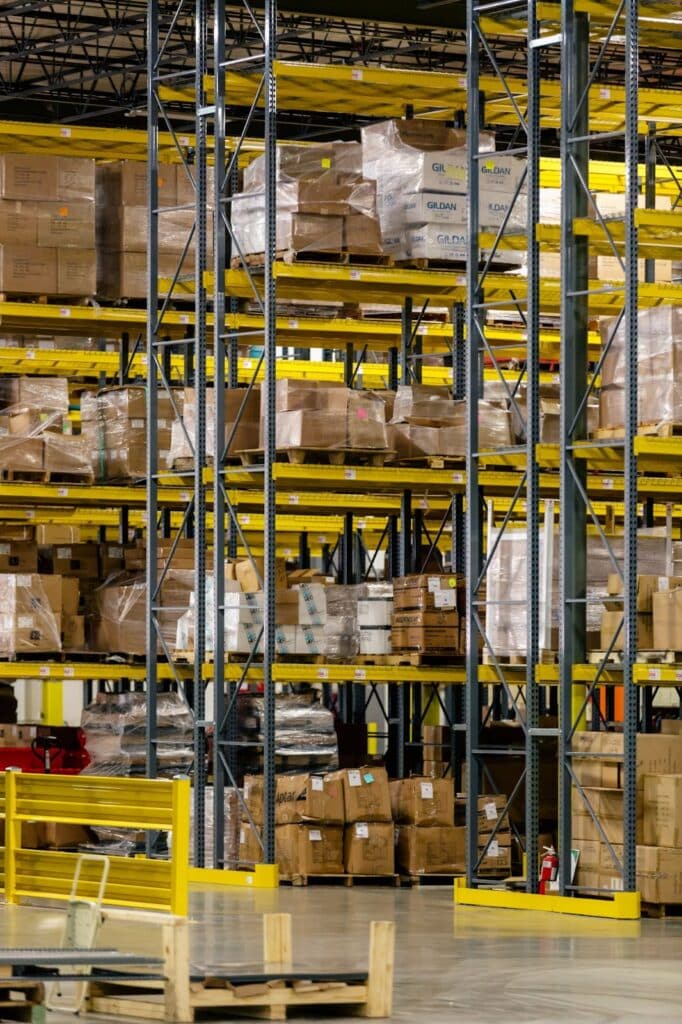The Ultimate Guide to Perpetual Inventory Systems: Benefits, Implementation, and Best Practices

In this guide, we’ll explore how a perpetual inventory system can revolutionize your business’ inventory management process and compare it to periodic inventory count systems.
Throughout this guide, you’ll learn about the key differences between a perpetual system and periodic inventory systems. We’ll also discuss the pros and cons of using a perpetual inventory system in various scenarios. This data will be useful when installing such a system inside your business.Read on for further information about perpetual inventory systems and how they can help you better manage your business.
What Is a Perpetual Inventory System?
A perpetual inventory system is an advanced method of tracking and managing the stock levels of goods in real time. This system continuously updates inventory records as transactions occur, providing businesses with accurate information on their available stock at any given time.
By leveraging modern technology such as barcode scanners and inventory management software, companies can efficiently monitor product movement throughout the supply chain, from procurement to sales.
The primary goal of implementing a perpetual inventory system is to maintain optimal stock levels while minimizing costs associated with excess or insufficient inventory. This approach enables businesses to make informed decisions regarding purchasing, production planning, and order fulfillment by accessing real-time data on merchandise inventory levels.
Key Components of a Perpetual Inventory System:
- Real-time updates: As products are bought, sold, or moved within the warehouse, the system automatically updates its records accordingly.
- Data accuracy: Continuous monitoring ensures that discrepancies between physical and recorded inventories are minimized.
- Detailed reporting: Comprehensive reports provide insights into trends related to sales performance, customer demand patterns, and potential issues within the supply chain process.
- Ease of integration: Modern perpetual inventory systems can integrate with other business tools like accounting software or enterprise resource planning (ERP) solutions for seamless data sharing across departments.
In this rapidly evolving business landscape, where customer requirements are in constant flux and competition is intensifying, a perpetual inventory system can be the secret weapon for companies seeking to optimize their supply chain operations and remain competitive.
What Is the Difference Between Perpetual and Periodic Inventory Systems?

Comparing the two systems, a perpetual inventory system and its counterpart, a periodic inventory system, is essential to understand their respective benefits. Both systems are methods for tracking and managing stock levels in businesses; however, they differ significantly in their approach.
Account Updates
A perpetual inventory system continuously updates stock levels as transactions occur. This real-time tracking provides accurate information on current inventory levels and quantities at any given time. On the other hand, a periodic inventory system only updates stock levels at scheduled intervals, typically at month-end or year-end when physical counts are conducted. This can lead to discrepancies between actual and recorded inventories due to theft, damage, or errors.
Calculating Cost of Goods Sold
The two systems also differ in how they calculate Cost of Goods Sold (COGS). In a perpetual inventory system, COGS is calculated automatically after each sale by multiplying the number of units sold by their respective costs per unit (source). Conversely, in a periodic inventory system, COGS is determined manually at specific intervals using beginning and ending inventories along with purchases made during that period.
Documenting Transactions and Purchases
- In a Perpetual Inventory System: Every transaction affecting an item’s quantity or cost is immediately recorded into accounting records such as general ledger accounts like “Inventory” and “COGS.” These real-time entries ensure accuracy while minimizing manual intervention required for reconciliations.
- In a Periodic Inventory System: Transactions are recorded in temporary accounts like “Purchases” and “Sales”. At the end of each accounting period, these transactions are then transferred to permanent inventory accounts through adjusting entries.
Investigating Issues
A perpetual inventory system allows for quick identification and resolution of issues such as stock discrepancies or data entry errors. Since updates occur in real-time, businesses can promptly address any inconsistencies that may arise. In contrast, a periodic inventory system only identifies problems during physical inventory counts at specific intervals, making it difficult to pinpoint when an issue occurred and delaying its resolution.
Pros and Cons of Using a Perpetual Inventory System
A perpetual inventory system offers several advantages for businesses, but it also comes with some drawbacks. This section will explore the advantages and disadvantages of employing a perpetual inventory system for your business. Read on to learn about the pros and cons of this system.
Pros:
- Real-time data: A significant advantage of using a perpetual inventory system is that it provides real-time information on stock levels. This allows businesses to make informed decisions about purchasing, production, and sales strategies based on accurate data.
- Better control over stock: With continuous updates to inventory records, companies can identify slow-moving items or potential stockouts quickly and take appropriate action to address these issues.
- Faster detection of discrepancies: Since transactions are recorded immediately in the system, any errors or discrepancies can be identified and resolved promptly.
- Easier forecasting: Accurate inventory records enable better demand forecasting and planning for future needs.
- Saves time & resources: By automating much of the record-keeping process through barcode scanning or RFID technology, businesses save time spent manually updating their books. Additionally, automation reduces human error associated with manual entry methods.
Cons:
- Strong dependency on technology: A perpetual inventory system relies heavily on technology, such as barcode scanners or RFID tags. This means that any technical issues could potentially disrupt the entire process and cause inaccuracies in inventory records.
- High initial costs: Implementing a perpetual inventory system can be expensive, particularly for small businesses. The cost of software, hardware, and employee training may pose challenges for companies with limited budgets.
- Requires continuous monitoring: Although a perpetual inventory system automates much of the record-keeping process, it still requires regular oversight to ensure accuracy and resolve discrepancies. This ongoing maintenance can be time-consuming for staff members.
Considering these pros and cons will help you determine whether implementing a perpetual inventory system is right for your business operations.
When to Use a Perpetual Inventory System

This section will discuss some of the most common situations where implementing a perpetual inventory system can be highly beneficial.
High-Value or Fast-Moving Items
If your business deals with high-value items or products that sell quickly, using a perpetual inventory system allows you to maintain accurate and real-time stock levels. This helps prevent stockouts and ensures optimal customer satisfaction.
E-commerce Businesses
E-commerce businesses often have multiple sales channels, such as online marketplaces and brick-and-mortar stores. A perpetual inventory system enables these companies to synchronize inventory across all platforms, ensuring consistent product availability and preventing overselling.
Growing Companies with Complex Supply Chains
A growing company with an increasingly complex supply chain can benefit from adopting a perpetual inventory system. The real-time inventory data provided by this method facilitates better decision-making when it comes to purchasing, production planning, and overall supply chain management.
Listed below are additional scenarios where utilizing a perpetual inventory system may prove advantageous:
- Promotional activities or seasonal fluctuations in demand require constant monitoring of stock levels;
- Precise tracking of perishable goods;
- Better control over shrinkage due to theft or damage;
- Industries subject to strict regulatory requirements related to traceability (e.g., pharmaceuticals, food and beverage).
Ultimately, businesses should carefully assess their specific needs and challenges to determine whether a perpetual inventory system is the right choice. Business dimensions, including magnitude, merchandise type, sales rate, and supply network intricacy, should be taken into consideration when making a judgment on whether a perpetual inventory system is the correct option.
Key Formulas Used in Perpetual Inventory
In this section, we will discuss some of the key formulas used in perpetual inventory systems to help businesses effectively manage their stock levels and make informed decisions. These formulas include COGS, economic order quantity (EOQ), weighted average cost, and gross profit.
COGS
COGS is a crucial formula for determining the total cost incurred by a business to produce or purchase goods that have been sold during a specific period. This includes direct costs such as raw materials, labor expenses, and manufacturing overheads. Calculating COGS helps businesses understand their profitability and make better pricing decisions. The formula for calculating COGS is:
COGS = Beginning Inventory + Purchases – Ending Inventory
EOQ
EOQ is another important formula used in perpetual inventory systems to determine the optimal order quantity that minimizes both ordering costs and holding costs while maintaining adequate stock levels. By using EOQ, businesses can avoid overstocking or understocking issues which may lead to lost sales opportunities or increased storage and labor costs respectively. The basic EOQ formula is:
EOQ = sqrt((2 x Demand x Ordering Cost) / Holding Cost)
Weighted Average Cost
The weighted average cost method (also known as average costing) calculates the average cost of all items available for sale during a given period by considering both the beginning inventory value and inventory cost of additional purchases made throughout the period. This method helps businesses allocate costs evenly across all items, making it easier to track inventory value and calculate COGS. The formula for Weighted Average Cost is:
Weighted Average Cost = (Beginning Inventory Value + Additional Purchases) / Total Units Available for Sale
Gross Profit
Lastly, gross profit is a key financial metric that measures the difference between a company’s revenue and its COGS. This figure indicates how much money a business makes after accounting for the direct costs associated with producing or purchasing goods sold during a specific period. Gross profit helps businesses evaluate their overall profitability and efficiency in managing production or procurement processes. The formula to calculate gross profit is:
Gross Profit = Revenue – COGS
In addition to these formulas, there are various other calculations and tools used in perpetual inventory systems such as safety stock levels actual inventory amount, reorder points, lead time demand forecasting, etc., that help businesses optimize their inventory management practices.
FIFO vs. LIFO Perpetual Inventory Methods
When it comes to perpetual inventory systems, two primary methods are used for determining COGS and updating inventory records: First-In, First-Out (FIFO), and Last-In, First-Out (LIFO). In this section, we will explain and compare these two approaches.
First-In, First-Out (FIFO)
The First-In, First-Out method, or FIFO as it is commonly known in the industry, assumes that items purchased first in the periodic system are also sold first. This means that when a sale occurs within your business’ supply chain system under a FIFO-based perpetual inventory management approach:
- The oldest item in stock is removed from the inventory account;
- The COGS calculation includes the cost associated with acquiring that specific item; and,
- Newer items remain in stock until older ones have been completely depleted.
This method tends to provide more accurate results when dealing with perishable goods or products with short shelf lives since they need to be sold before their expiration dates.
Last-In, First-Out (LIFO)
In contrast to FIFO methodology, Last-in-First-out (LIFO) assumes that items most recently added into your company’s inventory are those being sold first. The following rules apply under this approach:
- The newest item in stock is removed from the inventory account;
- The COGS calculation includes the cost associated with acquiring that specific item; and,
- Older items remain in stock until newer ones have been completely depleted.
LIFO is usually used by businesses dealing with non-perishable goods or products with long shelf lives. It may be advantageous for firms going through increased expenditures to utilize LIFO, as this could permit them to report lower gains and possibly lessen their tax duties.
FIFO vs. LIFO: Which Method Is Best?
Deciding which inventory method to utilize is contingent upon your business and the characteristics of your stock. Here are some factors to consider when choosing between these two methods:
- Nature of products: If you’re dealing with perishable goods, FIFO might be a better choice since it ensures older items are sold first;
- Tax implications: Businesses facing increasing costs may prefer using LIFO as it could result in lower taxable income due to higher COGS calculations;
- Economic conditions: During periods of inflation, FIFO tends to produce higher net income figures while LIFO generates more conservative results; and,
- Growth strategy: Companies looking for rapid growth might choose FIFO because it provides a more accurate reflection of current market values.
Frequently Asked Questions
Below are some of the most frequently asked questions about using a perpetual inventory system.
Does a perpetual inventory system use FIFO or LIFO?
A perpetual inventory system can utilize the FIFO (First-In, First-Out) or LIFO (Last-In, First-Out) method. The selection of FIFO or LIFO will depend on the particular needs and desires of the company. FIFO is more commonly used as it reflects a natural flow of goods in most industries where older items are sold before newer ones.
How do you record a perpetual inventory system?
When recording transactions in a perpetual inventory system, businesses must update their records continuously whenever stock is added or removed from their inventories. This can be done manually using spreadsheets; however, modern companies often opt for specialized software solutions like QuickBooks, NetSuite, or TradeGecko.
Final Thoughts
Using perpetual inventory systems can help you better manage your business. Should you opt to use this type of inventory management, you should understand the main benefits and pitfalls before switching your operations. If you want to improve your logistics operations, consider implementing a perpetual inventory system.
